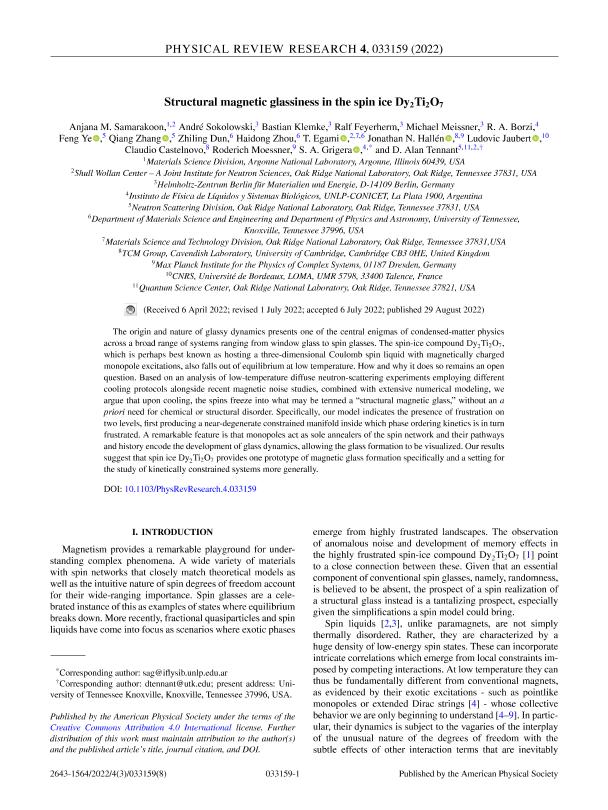Mostrar el registro sencillo del ítem
dc.contributor.author
Samarakoon, Anjana M.
dc.contributor.author
Sokolowski, André
dc.contributor.author
Klemke, Bastian
dc.contributor.author
Feyerherm, Ralf
dc.contributor.author
Meissner, Michael
dc.contributor.author
Borzi, Rodolfo Alberto

dc.contributor.author
Ye, Feng
dc.contributor.author
Zhang, Qiang
dc.contributor.author
Dun, Zhiling
dc.contributor.author
Zhou, Haidong
dc.contributor.author
Egami, T.
dc.contributor.author
Hallén, Jonathan N.
dc.contributor.author
Jaubert, Ludovic
dc.contributor.author
Castelnovo, Claudio
dc.contributor.author
Moessner, Roderich
dc.contributor.author
Grigera, Santiago Andrés

dc.contributor.author
Tennant, D. Alan
dc.date.available
2023-09-22T13:41:26Z
dc.date.issued
2022-08
dc.identifier.citation
Samarakoon, Anjana M.; Sokolowski, André; Klemke, Bastian; Feyerherm, Ralf; Meissner, Michael; et al.; Structural magnetic glassiness in the spin ice Dy 2 Ti 2 O 7; American Physical Society; Physical Review Research; 4; 3; 8-2022; 1-8
dc.identifier.uri
http://hdl.handle.net/11336/212670
dc.description.abstract
The origin and nature of glassy dynamics presents one of the central enigmas of condensed-matter physics across a broad range of systems ranging from window glass to spin glasses. The spin-ice compound Dy2Ti2O7, which is perhaps best known as hosting a three-dimensional Coulomb spin liquid with magnetically charged monopole excitations, also falls out of equilibrium at low temperature. How and why it does so remains an open question. Based on an analysis of low-temperature diffuse neutron-scattering experiments employing different cooling protocols alongside recent magnetic noise studies, combined with extensive numerical modeling, we argue that upon cooling, the spins freeze into what may be termed a "structural magnetic glass,"without an a priori need for chemical or structural disorder. Specifically, our model indicates the presence of frustration on two levels, first producing a near-degenerate constrained manifold inside which phase ordering kinetics is in turn frustrated. A remarkable feature is that monopoles act as sole annealers of the spin network and their pathways and history encode the development of glass dynamics, allowing the glass formation to be visualized. Our results suggest that spin ice Dy2Ti2O7 provides one prototype of magnetic glass formation specifically and a setting for the study of kinetically constrained systems more generally.
dc.format
application/pdf
dc.language.iso
eng
dc.publisher
American Physical Society

dc.rights
info:eu-repo/semantics/openAccess
dc.rights.uri
https://creativecommons.org/licenses/by-nc-sa/2.5/ar/
dc.subject
magnetism
dc.subject
frustrated materials
dc.subject
glassiness
dc.subject
spin ice
dc.subject.classification
Física de los Materiales Condensados

dc.subject.classification
Ciencias Físicas

dc.subject.classification
CIENCIAS NATURALES Y EXACTAS

dc.title
Structural magnetic glassiness in the spin ice Dy 2 Ti 2 O 7
dc.type
info:eu-repo/semantics/article
dc.type
info:ar-repo/semantics/artículo
dc.type
info:eu-repo/semantics/publishedVersion
dc.date.updated
2023-06-29T10:30:06Z
dc.identifier.eissn
2643-1564
dc.journal.volume
4
dc.journal.number
3
dc.journal.pagination
1-8
dc.journal.pais
Estados Unidos

dc.description.fil
Fil: Samarakoon, Anjana M.. Oak Ridge National Laboratory; Estados Unidos. Argonne National Laboratory; Estados Unidos
dc.description.fil
Fil: Sokolowski, André. Helmholtz-zentrum Berlin Für Materialien Und Energie; Alemania
dc.description.fil
Fil: Klemke, Bastian. Helmholtz-zentrum Berlin Für Materialien Und Energie; Alemania
dc.description.fil
Fil: Feyerherm, Ralf. Helmholtz-zentrum Berlin Für Materialien Und Energie; Alemania
dc.description.fil
Fil: Meissner, Michael. Helmholtz-zentrum Berlin Für Materialien Und Energie; Alemania
dc.description.fil
Fil: Borzi, Rodolfo Alberto. Consejo Nacional de Investigaciones Científicas y Técnicas. Centro Científico Tecnológico Conicet - La Plata. Instituto de Física de Líquidos y Sistemas Biológicos. Universidad Nacional de La Plata. Facultad de Ciencias Exactas. Instituto de Física de Líquidos y Sistemas Biológicos; Argentina
dc.description.fil
Fil: Ye, Feng. Oak Ridge National Laboratory; Estados Unidos
dc.description.fil
Fil: Zhang, Qiang. Oak Ridge National Laboratory; Estados Unidos
dc.description.fil
Fil: Dun, Zhiling. University of Tennessee; Estados Unidos
dc.description.fil
Fil: Zhou, Haidong. University of Tennessee; Estados Unidos
dc.description.fil
Fil: Egami, T.. University of Tennessee; Estados Unidos. Oak Ridge National Laboratory; Alemania
dc.description.fil
Fil: Hallén, Jonathan N.. Max Planck Institute For The Physics Of Complex Systems; Alemania. University of Cambridge; Estados Unidos
dc.description.fil
Fil: Jaubert, Ludovic. Max Planck Institute For The Physics Of Complex Systems; Alemania
dc.description.fil
Fil: Castelnovo, Claudio. University of Cambridge; Estados Unidos
dc.description.fil
Fil: Moessner, Roderich. Max Planck Institute For The Physics Of Complex Systems; Alemania
dc.description.fil
Fil: Grigera, Santiago Andrés. Consejo Nacional de Investigaciones Científicas y Técnicas. Centro Científico Tecnológico Conicet - La Plata. Instituto de Física de Líquidos y Sistemas Biológicos. Universidad Nacional de La Plata. Facultad de Ciencias Exactas. Instituto de Física de Líquidos y Sistemas Biológicos; Argentina
dc.description.fil
Fil: Tennant, D. Alan. University of Tennessee; Estados Unidos. Oak Ridge National Laboratory; Estados Unidos
dc.journal.title
Physical Review Research
dc.relation.alternativeid
info:eu-repo/semantics/altIdentifier/url/https://link.aps.org/doi/10.1103/PhysRevResearch.4.033159
dc.relation.alternativeid
info:eu-repo/semantics/altIdentifier/doi/http://dx.doi.org/10.1103/PhysRevResearch.4.033159
Archivos asociados
